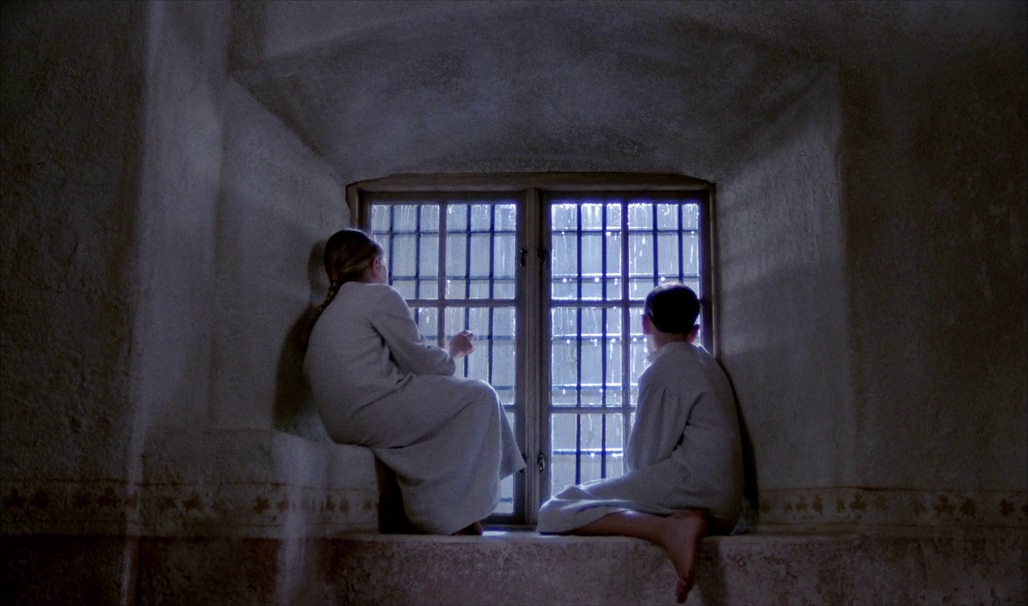Now that I’ve got into the world of Bergman, everything has changed. Before being a psychologist and a thinker, Bergman’s a master technician, a great visual storyteller, and a true artist who saw cinema as a serious art form, who tested and expanded the possibilities of cinema, and who constantly reinvented himself even while dealing with the same themes throughout his career.
Speaking of visuals alone, his black-and-white films are magnificent, especially his collaborations with Sven Nykvist such as Persona, Winter Light and Through a Glass Darkly. I don’t understand people who refuse to watch black-and-white films—colour can be a distraction, the absence of colour draws the viewer’s attention to the composition of the frame and the lighting, and helps notice the contrast and all the shades.
Then when he makes colour films, he makes the best use of colours. Cries and Whispers is the best example. The film is dominated by 3 colours, red, white and black. The main colour red conveys passion, hatred, blood, violence, death and extreme emotions, effectively used not only in production design and costumes but also in fade-outs (instead of black or white fades), a daring choice, and the few (2, I think) scenes with green grass in the film, by contrast, create a strong sense of claustrophobia in the indoor scenes, which heightens the intensity and at the same time makes the viewer feel that the sisters are somehow imprisoned by the way they are.



Lately, I’ve just watched Fanny and Alexander, the 5-hour version. As in Cries and Whispers, the cinematographer is the wonderful Sven Nykvist. It is 1 of the most visually beautifully films I have ever seen. Every single frame is like a painting (there’s only another film that makes me feel that way, Barry Lyndon, but the film as a whole is hollow). The colours and lighting are perfect, Fanny and Alexander looks magical in all the scenes at the Ekdahls’ house, and there’s a kind of balance and harmony in every frame that I can’t quite explain—I can only say it’s very pleasing and even exhilarating.
More importantly, Ingmar Bergman experiments and reinvents himself. Persona, written when he was in the hospital, was unlike anything he had previously made; and unlike anything I’ve ever seen. It’s new and interesting on many levels, but 1 of the most discussed things is the film reel at the beginning and ending of the film, and how the film cracks and burns in the middle—Persona is a film that reminds the audience that it is a film. However, it doesn’t make me feel the way I feel about Godard sometimes—breaking rules for the sake of being irreverent and experimental. The reminder of the artifice of film goes with the mental breakdown of the actress played by Liv Ullmann, and her silence because of her feeling about the crudeness of art, the artificiality and insincerity of her profession as an actress, and all the masks she wears in real life. The crack in the middle of the film denotes the breakdown, the dissociation of the nurse—when she on the 1 hand betrays the principle of her profession, and on the other hand, loses her sense of identity.
Together with Persona, Cries and Whispers is another film where Ingmar Bergman felt he went as far as he could go. A film about dying, and death, and people who are alive but inside already dead, and about a person who has died but is stuck halfway, Cries and Whispers is his most painful and intense film. As Roger Ebert has put it, “to see it is to touch the extremes of human feeling”. His use of the colour red is not merely symbolic—it creates strong emotional and dramatic impact, heightens the intensity, and makes us feel confined and claustrophobic. Nevertheless, it’s not as negative as it sounds—the selfless love and devotion of Anna, the servant, negates the selfishness and heartlessness of the sisters, and in the end, Cries and Whispers, despite everything, is life-affirming.
Then, after about a dozen films, when I thought I knew Ingmar Bergman, I watched Fanny and Alexander. The themes are the same, but the film is different, not only because the film has children and many things are seen through the eyes of an imaginative 10-year-old boy, but also because it’s warm, exuberant and magical, like a fairytale, and Dickensian in many ways (with children, a cruel stepfather that is a bishop, a Jewish art-dealer and money-lender…). It’s a wonderful farewell to cinema. It is full of life, and magic.







Ingmar Bergman is the greatest of filmmakers.
14/7 was his 99th birthday, and 30/7 is the 10th anniversary of his death.
wonderful post... i see IB differently now than i did.. tx...
ReplyDeletei was just browsing on Netflix and i saw a film, "Bergman's Island", purportedly a biography of the film maker...
ReplyDeleteNice.
ReplyDeleteI haven't seen any documentaries about Ingmar Bergman.
Does my post make you like to watch his films, though? :D
well, it sort of piques my interest... but i'm just not a very consistent filmist, i guess you'd say; my main focus is on bookish stuff...
ReplyDeleteI see.
ReplyDeleteI myself love both literature and cinema.